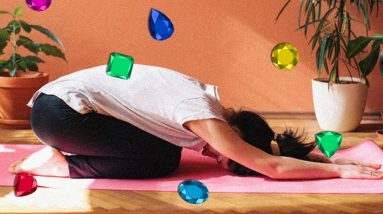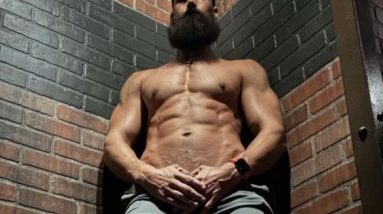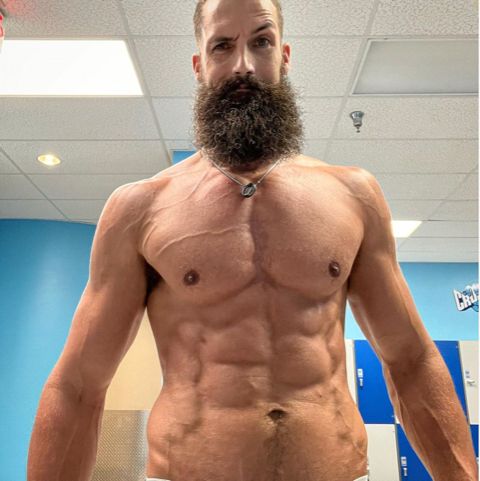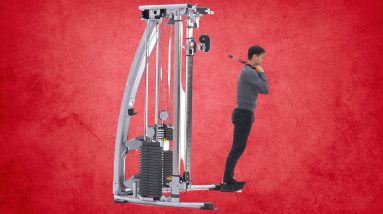
Former NFL Quarterback Christian Ponder is Revolutionizing the Mindset of Retired Athletes in the ‘Post’-Sports Era
Former NFL star Christian Ponder discovered early in his career that a quarterback’s success oftentimes came down to preparation. Now as an entrepreneur, he’s parlaying those football experiences—both good and bad—and other athletic attributes to help former athletes in their transition from the field to the boardroom.
In September, Ponder launched The Post, a private membership club comprised of only professional college and former Olympic athletes. Ponder along with co-founder Jason LaRose, came up with the idea of this sports safe space with the intention of helping create a leadership network for ex-athletes to make the transition to the business world once their careers came to a close.
The adjustment from gameday to life after sports isn’t always seamless—it even affected Ponder, who had earned an MBA while playing at Florida State from 2007-2010, and was already prepared for a post-football life in finance.
“It didn’t take me long like mentally to be like alright, it’s over, it’s time to move on,” Christian Ponder says. “But there was a bit of paralysis by analysis when sports was over. You can choose any path to go down when it comes to do that next chapter, but it’s hard because it’s like, what am I good at? What am I actually interested in outside of sports and it does take a little bit of time to navigate that part of it.”
Ponder adapted, just as he did while during his collegiate days with the Seminoles. It wasn’t as if the Dallas, TX, native’s gameday preparation was ever incomplete. However, an abundance of interceptions—13 INTs as a sophomore at Florida State—as well as a whole host of admittedly bad decisions had placed Christian Ponder at a quarterback crossroads early in his career.
While calls for his benching grew louder, Christian Ponder quietly retreated to the film room, using whatever down time he had to elevate his ability to better read defensive coverages through countless hours of film study. At the same time, with the extra work, he, along with the help of then-offensive coordinator (and eventual head coach) Jimbo Fisher, was able to find and fix the multitude of “correctible errors” that had plagued his 2008 season.
The added prep was partly responsible for a complete offensive turnaround his junior and senior seasons. His interceptions had dropped significantly, his touchdowns increased, and his overall performance was not only helping silence the naysayers—he even got some early season Heisman whispers. His talents and leadership helped elevate his draft status when he was selected 11th pick in the 2011 NFL draft by the Minnesota Vikings. In his second season, Ponder led the Vikings to a playoff appearance.
“Coach Fisher always said the game was won and lost before you ever stepped on the field because of how you prepared, Ponder says. “So if you’re struggling you got to just reinvest much more effort and that much more time to prepare to be able to have that confidence to step on the field and play your best.”
Ponder says the ability to adapt through adversity is one of the attributes that makes athletes successful in the business world. It’s been reported that more than 90 percent of Fortune 500 CEOs played sports, and 52% of all female C-suite CEO played collegiately. With the Post, Ponder has created a club for this like-minded business types to use their skills and resources and sports skills—preparation, teamwork, and the intense commitment to competition—to help others find success in their post-athletic endeavors.
“It’s what we’ve kind of coined the athlete operating system, which is a set of intangibles—work ethic, grittiness, competitiveness and dealing with failure,” Christian Ponder says. “Dealing with it not in a depressing way, but how am I gonna learn from failure even and apply that to the next time. [Athletes are] coachable, ambitious and always trying to achieve more. And I just think those characteristics translate so well into business and sets you up for success.”
While Christian Ponder is continuing to help develop a Winning Strategy for helping other athletes achieve success, the same formula can be applied to his fitness as well. At age 35, Christian Ponder has maintained his NFL playing weight—225 pounds—relying on recycled Vikings training journals he kept for his post-football regiment.
Ponder admits to training with not quite the same intensity as he did during his playing days, when he was a member of the 400-pound bench club while starring at Florida State. These days his muscle maintenance is inspired by maintaining the good graces of his wife, ESPN host Samantha Ponder, by sticking to an agreement they made just after the couple tied the knot.
“After we got married she said, ‘Look when you’re done playing football, you can’t lose 10 pounds and you can’t go over 10 pounds from when we got married,” Christian Ponder recalls. “My playing weight was 225. So I can’t go past 235, and can’t get super skinny. So 225 was an ideal weight was to maintain. It gets harder as you get older…but I’m still right there.”
Winning Strategy: Christian Ponder 1. Most Mistakes Can Be Fixed, if You Work to Find and Correct Them
I had a lot of failures, a lot of bad picks, and just many bad plays. I think back to my redshirt sophomore year at Florida State. It was a bad season. A lot of people thought I shouldn’t be the starter for the next year. But what I did was I spent a lot of time in the film room. I spent a lot of time with my coaches, but also a lot of time by myself figuring out like, Why did you make all those stupid mistakes? What was happening? It made me a lot more confident to realize they were stupid mistakes—all preventable things, and up to me to invest in the time to get better, to study and understand defenses.
I think [former FSU coach] Jimbo Fisher had such a great perspective when it came to quarterbacks and success at the quarterback level. He would ask the question, “Why are we doing this?” “On this play, why is the pass route designed this way against this coverage and who are you identifying? Is it the corner? Inside linebacker? Outside linebacker? Safety? So spending a lot of time learning from that season really helped me have an incredible junior year. I think even after my junior year I could’ve turned pro in the NFL draft, but I had another failure—three interceptions against Clemson. The third [int] would’ve been been a pick 6, and I was so mad I tried to blow up a 230-pound safety—he barely moved and I ended up separating my AC joint and couldn’t go in the draft.
There have been a lot of failures. But what I learned from my sophomore year made me a better player.
 The Post2. Embrace Self Awareness
The Post2. Embrace Self Awareness
I appreciate feedback. There are times when it gets hard—it’s hardest when you’re not playing well and you’re not you’re confident. If it keeps piling on it can hurt your confidence. And confidence is really important, especially at the quarterback position and as you get into the higher levels where the pressure is the highest.
Losing your confidence is detrimental to your performance. But I think criticism is an important part of growth. And we have to be aware of the things that aren’t going well. One of the biggest strengths athletes have is this hyper-awareness and self criticism around things like, what went well, but also and more important, what didn’t go well with my performance and how to identify those things. Whether it’s through a coach criticizing me or any other forms of criticism, or just my own criticism against myself, I have to know the things that I can get better at and put in the effort to get better so I can perform better.
At the Post we believe in the strength of self awareness. So the resources that we offer our members include how to invest in self awareness. And then our job is to bring the resources to help our members get better at whatever they identify as things that they may be a little bit deficient in. We can help them get better and offer pathways of growth.
Obviously we don’t criticize people, we help people identify things that they can continue to get better at and how do we help them get there. That’s a part of the athlete journey. That’s a part of everyone’s journey, right? I think it’s your choice, whether you want to have some honest conversations with yourself and if you want to get better, you’ve got to figure out what you can get better at and how to do it.
 The Post3. A Strong Athletic Mindset Requires A Strong Physical Presence
The Post3. A Strong Athletic Mindset Requires A Strong Physical Presence
What was so great about being in sports and football was that you had so much structure, especially when it came to working out. You always had a strength coach and a program. I knew that my time playing would eventually end, so I actually kept a lot of my workout books, especially during my time with the Minnesota Vikings, so I still try to follow similar things.
I belong to an Equinox in New York right down the street from me. And as much as I just hate working out in public gyms—where [many] guys aren’t used to like being in weight rooms and putting weights back or like, God forbid, you can’t go get a drink between your sets or someone’s gonna steal your bench. It drives me nuts, but I still try to get to the weightroom about five days a week. I don’t need to be as fit as I was on the football field and don’t need to be throwing around as much weight as I did while I was playing
I’ll also run in Central Park with a buddy of mine a few times a week, as well as do some anaerobic stuff like hill runs. I also play in a basketball league that’s both fun and competitive but also a great workout.
These days, however, I don’t have as much time. Back then it was your job to stay fit and you dedicated your time in the weightroom and conditioning throughout the day. It’s not the case now. I have three kids and I’m the founder of a startup. I don’t have the same amount of time, you know, to spend 90 minutes in the gym and work out.
I’ve learned that sometimes it’s OK to just get 30 minutes in and do what you can. That’s definitely different, and I’ve had to accept that. It got to the point a few years where it was like there was no point to a 30-minute workout. So I wouldn’t work out at all. So it became a change in routine and a change in mindset. I’m not trying to kill myself. At this point, it’s maintenance for me, not about throwing up big numbers. I just want to stay fit enough that I can keep chasing my kids around and live a long healthy life.
View this post on InstagramA post shared by Christian Ponder (@cpseven)
4. Why Christian Ponder Believes Athletes Need Outlets Like The Post
I got my undergrad in finance, and got my MBA while still playing at Florida State. I knew I wanted to get into finance. That’s one of the main reasons we moved to New York, it’s the financial capital world, I think on paper I had it all together. I didn’t expect the transition to be difficult, but it was. I think going through that experience was a big motivating factor for launching the Post.
We’re not trying to help athletes in transition. What we’re trying to do is build a community for athletes to transition into when they’re done. Like what I had when I transitioned to college or when I transitioned to the NFL, we kind of had this veteran locker room to step into and just like we had where you have players who were juniors and seniors in college or players in the NFL for 10-plus years, who knew what it took to compete at that level as a young person. Your building relationships. Learning via osmosis to figure how to compete at that level.
It’s the same what we’re trying to do: How do we take former athletes who are doing extremely well in business because of their athletic background. For me life [post-football] was a loss of identity, a sense of purpose, structure and routine and a loss of community. So for us at the Post, it’s about how to combat that.
Athletes shouldn’t shed their identity when they’re done—success in sports and business require the exact same qualities. In business you’ve got to work hard, you’re gonna be introspective, have great goals, and you’re gonna deal with failure— all the things that made you a great athlete.
View this post on InstagramA post shared by Christian Ponder (@cpseven)
5. Find Your Group of Like-Minded Teammates
In creating the Post, I knew I wasn’t alone. You talk to so many athletes about what they miss most about playing, and it’s usually some version of missing the locker room or the team, which is just another word for community. So I knew I wasn’t alone in those feelings, and before you know, I saw these ideas started happening. I got a lot of feedback, like, why hadn’t this been built already? It seems like an obvious ideas. And I don’t know the answer to that, but I just built it on selfish ambition because I just missed being around other athletes, so I knew I couldn’t have been the only one.
We’re just trying to build that space for athletes to reconnect with their community. Again, it’s a community we’ve been a part of for so long. And what we’re trying to do is create that sports ecosystem that we all participated in, and was created in a way to get the best out of us when it came from an athletic perspective or potential. You had teammates who were there to support you and push you along the way. You had coaches and training and all these resources to unlock as much of that athletic potential as possible. We’re just trying to take that same ecosystem, that same group of people and try to unlock or harness all of that professional business potential that athletes possess because of that athlete operating system as we call it.
So if you miss being a part of that community, if you identify as an athlete, we’re here for you. Our members go from mid 20s to mid 70s. our theme is once an athlete always an athlete, and I think one of the things about athletes is that we always thought our best performance was still ahead of us, so it will always still get better. For us, we’re trying to be that that grease on the wheel that helps you get there.

Discover the Serene Power of Embracing Child’s Pose Throughout Your Entire Yoga Class
In a dimly lit yoga studio, I was somewhere between cat-cow and threading the needle when tears started swelling up in my eyes. The feeling of deep grief and hopelessness I fought back all day came to a climax while I was on my Lululemon mat. I quickly folded forward into a child’s pose, ignoring the instructor’s flow, and I stayed put for the rest of class. Doing so felt most aligned for me in the moment.
The power of tuning into what your body and soul needs in the present moment is honest and liberating. But that day in the studio, when I was was overcome with emotion, I wasn’t focused first and foremost on what my body was asking of me. Rather, I was just trying to get myself into a compact position, so as to not be remembered “yoga-class crier.”
I laid there raw, belly between my thighs, arms stretched forward like two railroad tracks, and my head peeking between them. Intrusive thoughts took up residence in my mind: Did the teacher think I was being disruptive? Did the other students see me as an annoyance? Yoga is about taking what you need, right?
I’m a certified yoga teacher who had, at that point, facilitated dozens of classes, during which I’d invited students to consider child’s pose, or balasana, as their home base. I welcomed them to find it at any point in class when they needed a moment to recenter or find their breath. During the yoga class when I found myself in child’s pose as a calming measure, I found myself needing to take my own advice—to take a breath, as I was searching for a home.
A reminder: Child’s pose is yoga
Yoga, which means “union,” in sanskrit refers to a marriage of the mind, body, and soul. Meaning, it’s much more than a purely physical exercise. The asanas, or yoga postures, are just one tool yoga offers to help bring the mind to a state of awareness. Asanas alone, though, are not reflective of the full meaning of yoga.
The eight limbs of yoga are philosophies from Patanjali’s Yoga Sutra, which aim to teach how to live a meaningful life and provide a path to enlightenment. Asana is one of the eight limbs. Samadhi is the last phase of the eight limbs of yoga, and it’s characterized by intense focus and arriving at a state of bliss and union with the self. But sometimes, you must wrestle or struggle to access peace, and clarity.
Maintaining my child’s pose was my personal struggle during that class. I chose to tune in to the strong emotions that washed over me as I sought solace; I resisted the urge to get up and back into the flow, in light of fear for what classmates may have thought of me. I didn’t allow my ego to bully me into prioritizing external acceptance over internal need. With deep breaths and a surrendered heart to the earth, I sat in the uncomfortable awareness of it all for the duration of class.
Even so, I never intended to go to yoga class and then break down emotionally. I didn’t consciously realize that I was in a depleted state and needed turn inward before I could outwardly express. After paying the $28 class rate, I fully intended to participate. In fact, movement often supports me in releasing my uninhibited emotions. But my body—as I would soon learn—was beckoning for something different.
Remaining in a child’s pose allowed me to experience my most authentic form of practice at that moment: awareness of self.
Remaining in a child’s pose allowed me to experience my most authentic form of practice at that moment: awareness of self. And immersing myself into my feelings in that one pose for the duration of class was a a fruitful yoga experience.
There’s no way to control when your proverbial dam breaks, and the resulting flow of emotions may overtake you. When this happens, it’s important to take solace in knowing that the only path to liberation is through the chaos. After you fall apart is when you tend to grow. What may feel like destruction, pain, and turmoil in the moment, is what gives way to fertile soil where you can plant new seeds. From there, opportunities can emerge. Sometimes, getting to that fertile ground may involve crying in child’s pose for an entire yoga class.
Child’s pose can be the ‘right use of energy’
Staying in one posture for an extended period of time supported my total emotional surrender. I allowed myself to soften in a way that movement-focused yoga flows wouldn’t have supported. As my forehead touched the ground, I felt safe to fall apart. Soon, tears spilled over the edges of my mat. When moments of self-doubt arose, I self-soothed by rocking my forehead back and forth. I began tapping into my vagus nerve, activating my parasympathetic nervous system, which contributes relaxation of the body. I acknowledged the temporary nature of my feelings, and affirmed I wouldn’t always feel scattered, but in that moment of barely holding on, my emotions were valid and welcomed. I embodied compassion for myself.
There is a yoga principle called brahmacharya, which means “the right use of energy.” Brahmacharya encourages us to be transformed by our yoga practice by listening to our body and letting the practice serve us; by directing our power away from external desires and instead toward finding peace and happiness within ourselves.
Given that yoga means “union,” it’s crucial that I remain open to receive what I need, even if it shows up in a way that feels disruptive. There is a proclivity in movement classes—and life—to push ourselves beyond our edge; to keep up and look accomplished. What if the real accomplishment were giving yourself precisely what you needed, moment by moment, no more or less? To embrace yourself as you are, with all your weaknesses and strengths? To affirm you are powerful and you always have the choice to take what you need unabashedly? That feels like a worthwhile way to spend a yoga session to me. And so I continue inviting students of mine and myself to consider child’s pose as calming home base in yoga.

My Journey to the Top 3 in “Squid Game: The Challenge” – Unveiling My Fitness Regimen, Winning Tactics, and the Notorious Green Outfits – By Sam Lantz
As a reality television watcher, I became deliriously happy when “Squid Game: The Challenge” picked me to appear on the show’s first season on Netflix.
But after whooping it up with my husband, I got down to work.
Reality shows are usually physical, requiring people to push their bodies to the limit. As an avid gym rat, I wasn’t worried. Working out is about positive mental health for me, which is why I hit the gym seven days a week. I’m tall — a towering 6’7” — so my focus is on “putting roots into the ground,” meaning making my tall frame as still as possible, so I’m not only focusing on whatever muscles I’m working on, but I’m also firming up my core to get a secondary workout as well.
I have three different abdominal/core routines that I like. I choose one to finish with every day: either 2 sets of 25 reps of leg lifts, or 2 sets of 25 reps of side and flat planks, or 2 sets of 25 reps on whatever ab machines are available. Finishing with a different ab workout every day keeps the muscles from becoming too complacent. Working out didn’t come natural to me. In my early life I was a super skinny kid who hated his body. My confidence in the gym came from figuring out that the gym wasn’t a scary place but instead was a space to simply make myself feel better; almost my therapy. Everyone needs that, but especially young people like me who didn’t have the family support to survive life, no less reality television.
So how did the lessons I learned from my workout regimen help me survive all 10 episodes of “Squid Game” where I ended up as one of three finalists out of 456 players?

First, I had watched the original scripted “Squid Game” series that preceded the reality version. Through three separate viewings I knew I would need to prepare to survive games like “Red Light Green Light” that required fast sprints and frozen posing. So, before the January 2023 taping, I prepared by running a quarter of a mile every day on a treadmill. I typically don’t like running, but after that regimen my body assimilated to jumping into sudden action.
Secondly, I knew that the real physical pain from “Squid Game” would be mental. Like most reality shows, the players are confined from the outside world. We were completely infantilized. We lived together in a dorm for 17 long days, only saw sunlight a limited amount every day, didn’t know the time, watch the news, or have a cell phone, and we ate every meal together. It’s no surprise, then, that our emotions hung from a thread — which makes for great television, but oftentimes not great decision-making.
For this I prepared by learning meditation to calm myself every morning, or whenever it was needed. It especially came in handy in the “white room of doom” where we were staged before each challenge. I also came to peace with giving up control. My “Squid Game” life existed in an artificial world created by the show’s producers. I knew to expect nothing, which helped give me the balance needed to survive sudden upsets or player drama. There was a flow to those 17 days, so I did my best to not fear it or fight it, but to flow along wherever it took me.
Finally, I hid my strengths. Luckily, the wardrobe design on “Squid Game” required players in shapeless green tracksuits. Mine was sized double extra-large, which meant it was easy to hide my physique. As a reality show watcher, I am aware of the universal rule that says the players who are the most in shape tend to have a target on their back because our reptilian brains tell us that they are threats.
I downplayed physical strength which helped me focus more on the social and mental rigor the game required. I became friends with everyone. I hugged people when they needed hugs, I shook hands and high-fived when others achieved victory. I made a specific choice to be everyone’s favorite number three — Not their best friend and not their worst enemy.
Instead, I just wanted to be the low-key guy who would never be considered a threat, and in a situation designed around identifying those who would be a threat to your game, this social interaction was key. In the end, the competition was less about physical challenges and more about social relationships, mental fortitude, and chance.
“Squid Game” gave me the gift of understanding that I can withstand anything. Growing up gay in a household that didn’t want me, I was often told I would never amount to anything. That gave me the strength I knew I had before “Squid Game.” But by pushing me to new extremes, I realized just how strong I had become.
The game of life is not unlike the game of television. My time on “Squid Game: The Challenge” didn’t result in millions in prize money, but I learned it had an unexpected payoff: an awareness of how strong I really am, outside and in.
Sam Lantz is an artist living in Fort Lauderdale. He was among the top three finalist in “Squid Game: The Challenge” on Netflix.

Tips for Strengthening Abs with the Standing Rope Crunch Technique
Are you looking for an exercise that can strengthen your core and help you get the toned midsection you desire? Standing Rope Crunches are the perfect solution! This challenging exercise targets your abdominal muscles, obliques and lower back, helping you build strength and burn calories. With FitGAG’s expert guide, you’ll be able to master Standing Rope Crunches and achieve your fitness goals. So what are you waiting for? Get started on your Standing Rope Crunch journey today!
Exercise Information
The Standing Rope Crunch is a resistance training exercise that targets the muscles in the core. This exercise involves using a rope to add resistance and challenge your core muscles throughout the entire range of motion, making it an effective workout for those looking to strengthen their core. Let’s dive into some general information about this exercise:
Level
The Standing Rope Crunch is suitable for individuals of all fitness levels, from beginners to advanced athletes.
Equipment
To perform the Standing Rope Crunch, you will need a rope.
Type of Exercise
The Standing Rope Crunch is an isolation exercise that targets the muscles in the core, involving a single-joint movement that mainly focuses on one specific muscle group.
Standing Rope Crunch: Working Muscles
The Standing Rope Crunch is an isolation exercise that primarily targets the muscles of the abdominal region. This exercise involves using a rope attached to a high anchor point, such as a pull-up bar, to add resistance to the traditional crunch motion. In this section, we will discuss the primary and secondary muscle groups that are involved during the Standing Rope Crunch exercise.
Primary Muscle Group: Abdominals
The primary muscle group targeted during the Standing Rope Crunch exercise is the abdominal region, including the rectus abdominis, transverse abdominis, and oblique muscles. These muscles are responsible for flexing the trunk of the body, which is the primary motion of the Standing Rope Crunch exercise.
Secondary Muscle Group: Shoulders
In addition to the primary muscle group, the Standing Rope Crunch exercise also engages the muscles of the shoulders. The rotator cuff muscles and middle deltoid muscles are engaged during the crunching motion to stabilize the joint and maintain proper posture.
By engaging both the primary and secondary muscle groups, the Standing Rope Crunch exercise provides a comprehensive core workout. This makes it an effective exercise for building abdominal muscle strength and size, improving posture and stability, and developing functional fitness for activities in daily life.
Stay tuned for the next section, where we will discuss the benefits of the Standing Rope Crunch exercise.
Benefits of Standing Rope Crunch
Standing Rope Crunch is an exercise that targets your core and offers several benefits. Here are five benefits of incorporating this exercise into your fitness routine:
- Improved Core Strength: Standing Rope Crunch helps improve your core strength by engaging your abdominal muscles and developing overall stability in the core.
- Enhanced Balance and Stability: Standing Rope Crunch engages more muscles in the upper and lower body, which can help improve overall balance and stability.
- Increased Range of Motion: Standing Rope Crunch allows you to work your core through a full range of motion, which can help improve your overall flexibility.
- Reduced Risk of Injury: Standing Rope Crunch can help improve your overall joint stability and reduce the risk of injury and strain on your abdominal muscles.
- Variation and Progression: Standing Rope Crunch can add variation to your core workouts, which can help prevent boredom and stimulate new muscle growth. Additionally, the exercise can be made more challenging by using a heavier rope or increasing the number of reps.
By incorporating Standing Rope Crunch into your fitness routine, you can enjoy these benefits and more. However, it’s important to start slowly and progress gradually to avoid injury and ensure proper form. Additionally, it’s important to incorporate a variety of exercises into your fitness routine to ensure you’re targeting all muscle groups and avoiding boredom.
Standing Rope Crunch: Step-by-Step Instructions
The standing rope crunch is an exercise that works your abdominals and obliques. Here are the step-by-step instructions for performing the standing rope crunch:
Starting Position:
- Hold a rope in both hands, with your palms facing each other.
- Stand with your feet slightly wider than shoulder-width apart.
- Tighten your core and keep your back straight.
Now, let’s move on to the step-by-step instructions for the standing rope crunch:
- Begin by crunching your core, bringing your elbows in towards your torso.
- Pause briefly at the end of the movement, when your elbows are just outside your chest.
- Slowly release the movement and bring your arms back to the starting position.
Repeat the movement for the desired number of repetitions.
Standing Rope Crunch – Proper Form and Technique
The Standing Rope Crunch is an effective exercise that targets the core muscles. This exercise is performed using a rope, and proper form and technique are important to avoid injury and achieve maximum results.
Starting Position
- Stand upright with your feet hip-width apart and the rope looped around your hands.
- Hold the rope with both hands, with your arms extended straight out in front of you.
- Engage your core muscles and maintain a stable base.
Proper Form and Technique
- Crunch the Rope: Crunch the rope by pulling the rope up towards your body, squeezing your core muscles.
- Keep Your Arms Straight: Keep your arms straight and your elbows slightly bent throughout the exercise, using your abdominal muscles to control the movement.
- Return to the Starting Position: Return to the starting position by bringing the rope back to the starting position in front of your body.
- Breathe Deeply: Breathe deeply and regularly throughout the exercise to maintain your energy and focus.
- Gradually Increase Intensity: Gradually increase the number of repetitions or sets of the exercise over time as your abdominal muscles become stronger.
- Incorporate into Your Routine: The Standing Rope Crunch can be a great addition to your core training routine, helping you to build strength and muscle effectively.
By following these tips, you can perform the Standing Rope Crunch with proper form and technique, building and strengthening your core muscles effectively while minimizing the risk of injury. Remember to start slowly, focus on your breathing, and gradually increase the difficulty and intensity of the exercise over time.
Frequency and Progression: How to Get the Most Out of Your Standing Rope Crunch Workouts
The Standing Rope Crunch is a resistance band exercise that targets the core muscles, specifically the obliques and rectus abdominus. In this section, we will discuss how to properly incorporate the Standing Rope Crunch into your workout routine and how to progress with this exercise over time.
Frequency
To see significant results with the Standing Rope Crunch, it is recommended to perform this exercise 2-3 times a week. However, it is important to listen to your body and avoid overtraining. If you feel any pain or discomfort, stop the exercise immediately. You can also alternate between the Standing Rope Crunch and other core exercises, such as planks or Russian twists.
Progressive Overload
To progress with the Standing Rope Crunch, it is important to gradually increase the difficulty of the exercise over time. Start with a lighter band resistance and gradually increase the resistance as you become stronger. Another way to progress is to decrease the rest time between sets or increase the number of repetitions. Gradually increase the resistance and reps/sets and avoid adding too much too quickly.
Mix It Up
To prevent boredom and keep your Standing Rope Crunch workouts fresh, it is important to mix up your exercise routine. You can perform the Standing Rope Crunch with different types of bands or vary the number of reps and sets. You can also incorporate other core exercises, such as bicycles or mountain climbers.
Proper Form
Proper form is essential when performing the Standing Rope Crunch to avoid injury and get the most out of the exercise. Start by holding the band with both hands and standing with your feet shoulder-width apart. Your hands should be in front of your chest with your elbows slightly bent. Pull the band apart by spreading your hands out to your sides, keeping your elbows in line with your shoulders. Squeeze your abdominal muscles together at the end of the movement. Return to the starting position by slowly bringing your hands back together. Keep your core engaged and your back straight throughout the movement.
Track Your Progress
To ensure you are making progress and staying on track with your Standing Rope Crunch workouts, it is important to track your progress. Keep a workout journal or use a fitness app to log the band resistance, reps, and sets for each exercise. This will help you identify areas where you need to improve and keep you motivated to continue pushing yourself.
Incorporating the Standing Rope Crunch into your core workout routine can be a great way to build strength and improve your posture. By following these tips for frequency, progressive overload, and proper form, you can ensure that you are getting the most out of your Standing Rope Crunch workouts and reaching your fitness goals.
Mistakes of Standing Rope Crunch Exercise
The standing rope crunch exercise is a great way to target your abdominal muscles and strengthen your core. However, like any exercise, there are common mistakes that can reduce its effectiveness and increase the risk of injury. Here are five mistakes to avoid during the standing rope crunch exercise:
- Not using proper form: Using poor form during the standing rope crunch exercise can reduce its effectiveness and increase the risk of injury. It’s essential to maintain proper alignment of the spine, hips, and shoulders throughout the exercise.
- Using too much resistance: Using too much resistance during the standing rope crunch exercise can increase the risk of injury and reduce its effectiveness. Instead, focus on using a rope with appropriate resistance that allows you to maintain proper form.
- Not using a full range of motion: Neglecting to use a full range of motion during the standing rope crunch exercise can reduce its effectiveness. Make sure to fully extend your arms in front of your body before returning to the starting position.
- Not engaging the abdominal muscles: Engaging the abdominal muscles is essential to ensure that you are targeting the correct muscles during the standing rope crunch exercise. Failure to engage these muscles can reduce the effectiveness of the exercise.
- Not using proper breathing: Using improper breathing technique during the standing rope crunch exercise can reduce its effectiveness and increase the risk of injury. Make sure to exhale as you pull the rope towards your chest and inhale as you return to the starting position.
By avoiding these common mistakes, you can ensure that you are getting the most out of your standing rope crunch exercise while reducing the risk of injury. Remember to use proper form, use an appropriate resistance, use a full range of motion, engage the abdominal muscles, and use proper breathing throughout the exercise. With consistent practice, you can improve your core strength and develop better posture with the standing rope crunch exercise.
Variations of Standing Rope Crunch: Add Challenge to Your Core Training
Standing Rope Crunch is a great exercise to help target and strengthen your core muscles. However, doing the same exercise every day can become monotonous over time. Here are some variations to add challenge and variety to your training routine and challenge your core muscles in different ways:
Single-Arm Standing Rope Crunch
This variation involves performing the exercise with one arm at a time, which adds more challenge to your balance and stability and targets your core muscles from a different angle. Be sure to keep your core engaged and your feet slightly apart as you perform the exercise.
Standing Rope Crunch with Resistance Bands
This variation involves using heavier resistance bands to add extra resistance and challenge your core muscles. Be sure to use proper form and technique and avoid jerking or pulling the bands.
Standing Rope Crunch with Pause
This variation involves pausing for a few seconds at the end of each repetition, which challenges your core muscles and improves your overall muscular endurance. Be sure to keep your core engaged and your feet slightly apart throughout the exercise.
Standing Rope Crunch with Isometric Hold
This variation involves holding the fully contracted position of the exercise for a few seconds, which challenges your core muscles and improves your overall muscular endurance. Be sure to keep your core engaged and your feet slightly apart throughout the exercise.
Standing Rope Crunch with Cross Body Reach
This variation involves adding a cross body reach to the exercise, which targets your core muscles and improves your overall core strength and stability.
Incorporating these variations into your Standing Rope Crunch routine can help you add challenge and variety to your core training and achieve greater gains in overall core strength and athletic performance. As always, make sure to use proper form and technique to avoid injury.
Standing Rope Crunch: 5 Alternatives to Strengthen Your Core
The standing rope crunch is a great exercise for strengthening your core and improving your posture. However, if you’re looking to mix up your routine or add some variety, there are plenty of alternatives you can try. In this section, we’ll explore five exercises that target your core and can help you build strength and improve your posture.
Plank
The plank is a great exercise for targeting your core and improving your posture.
- Lie face down on the floor and prop yourself up on your forearms.
- Engage your core and lift your body up, keeping your back straight and your feet together.
- Hold the position for the desired amount of time before lowering back down.
Bird Dogs
Bird dogs are a great exercise for targeting your core and building strength.
- Start on your hands and knees and extend one arm in front of you and the opposite leg behind you.
- Engage your core and keep your back and leg straight while you hold the position.
- Lower your arm and leg back down and repeat on the opposite side for the desired number of repetitions.
Hollow Holds
Hollow holds are a great exercise for targeting your core and building strength.
- Lie face up on the floor and lift your legs and arms off the ground.
- Engage your core and keep your back and legs straight while you hold the position.
- Lower your legs and arms back down and repeat for the desired number of repetitions.
Flutter Kicks
Flutter kicks are a great exercise for targeting your core and improving your posture.
- Lie face down on the floor and lift your legs off the ground.
- Alternate kicking your legs up and down while keeping your core engaged.
- Continue for the desired number of repetitions.
Crunches
Crunches are a great exercise for targeting your core and strengthening your abs.
- Lie face up on the floor and bend your knees so your feet are flat on the ground.
- Engage your core and crunch your chest towards your knees.
- Lower your chest back down and repeat for the desired number of repetitions.
Incorporating these alternatives to standing rope crunch exercises into your routine is a great way to strengthen your core and improve your posture. These exercises require little to no equipment and can be done at home or at the gym. Give them a try and see how they work for you!
Standing Rope Crunch: Tips and Tricks for Developing Stronger Core Muscles
The Standing Rope Crunch is an excellent exercise to help you develop stronger core muscles. In this section, we’ll share some tips and tricks to help you perform the Standing Rope Crunch correctly and get the most out of it.
- Warm-Up: Before performing the Standing Rope Crunch, it’s important to warm up your entire core. You can do this by performing some light cardio or dynamic stretching, such as side bends.
- Use the Right Equipment: To perform the Standing Rope Crunch, you need a rope and a sturdy object to secure it to. Make sure you choose the right resistance level for your needs and follow the manufacturer’s instructions for use.
- Proper Form: Maintaining proper form is crucial when performing the Standing Rope Crunch. Begin by holding the rope securely in both hands, with your palms facing down. Keeping your arms straight, pull the rope up until your hands are at chest level, then slowly return to the starting position.
- Engage Your Core Muscles: To perform the Standing Rope Crunch correctly, you need to engage your core muscles. Focus on squeezing your abs as you pull the rope up.
- Use the Right Repetition Range: Aim to perform 2-3 sets of 8-12 reps with the Standing Rope Crunch.
- Mix it Up: Mixing up your Standing Rope Crunch routine can help keep your workout fresh and challenging. You can try different variations, such as changing the resistance level or using a different hand position.
- Stretch Afterwards: After performing the Standing Rope Crunch, it’s important to stretch your entire core, especially your abs and lower back.
- Listen to Your Body: As with any exercise, it’s important to listen to your body and avoid pushing beyond your limits. If you feel any discomfort or pain, stop the exercise immediately.
Incorporating these tips and tricks into your Standing Rope Crunch routine can help you get the most out of this exercise and achieve stronger core muscles. Remember to always maintain proper form, engage your core muscles, and listen to your body. With time and practice, you’ll be able to perform the Standing Rope Crunch like a pro and enjoy the benefits of stronger and more toned core muscles.
Incorporating Standing Rope Crunches into Your Workout Routine for Maximum Effect
Standing rope crunches are a great exercise for strengthening your core and improving your posture. Here are some tips to help you incorporate this exercise into your workout routine for maximum effect:
- Warm-up properly: Before doing standing rope crunches, it’s important to warm up your core with exercises like side planks, bridges, and bird dogs.
- Use proper form: To perform standing rope crunches, stand with your feet shoulder-width apart and hold a resistance band with both hands. Extend your arms straight out in front of you, holding the ends of the band at shoulder height. Then, pull the band towards the top of your head by crunching your abs and bringing your elbows towards your knees. Return to the starting position and repeat.
- Mix up your routine: Don’t just perform standing rope crunches in isolation. Mix it up by incorporating other core exercises, such as planks, V-sits, and Russian twists.
- Use progressive overload: To continue to see progress, you’ll need to use progressive overload, which means gradually increasing the resistance or repetitions over time.
- Don’t overdo it: It’s important to give your muscles time to recover, so don’t overdo it with standing rope crunches. Aim to perform the exercise for 2-3 sets, 1-2 times per week.
- Focus on your breathing: It’s important to regulate your breathing throughout the exercise to ensure that you’re getting enough oxygen to your muscles. Inhale as you crunch and exhale as you return to the starting position.
- Engage your core: To get the most out of standing rope crunches, make sure to engage your core muscles, including your abs, lower back, and obliques. This will help you maintain proper form and prevent injury.
- Rest between sets: Allow your muscles time to recover between sets. Rest for 60-90 seconds between sets to ensure that you’re performing each rep with proper form.
- Incorporate standing rope crunches into your workout routine: In addition to incorporating standing rope crunches into your workout routine, consider doing them as part of a superset or a circuit to challenge your muscles even more.
By incorporating these tips into your workout routine, you’ll be well on your way to maximizing the benefits of standing rope crunches and achieving stronger core muscles and improved posture.
Ultimate Workout Plan for Standing Rope Crunch
Standing Rope Crunch is an excellent exercise for strengthening and toning your core. Here’s a one-week workout plan to help you incorporate Standing Rope Crunch into your routine:
Day 1: Warm-up
- Warm-up: 5-10 minutes of cardio
- Standing Rope Crunch: 3 sets x 12-15 reps
- Plank: 3 sets x 30-60 seconds
- Hanging Leg Raises: 3 sets x 10 reps
- Decline Crunches: 3 sets x 12 reps
- Cool-down: 5-10 minutes of stretching
Day 2: Rest Day Day 3: Lower Body
- Warm-up: 5-10 minutes of cardio
- Standing Rope Crunch: 3 sets x 12-15 reps
- Squats: 3 sets x 10 reps
- Lunges: 3 sets x 10 reps
- Calf Raises: 3 sets x 12 reps
- Cool-down: 5-10 minutes of stretching
Day 4: Rest Day Day 5: Full Body
- Warm-up: 5-10 minutes of cardio
- Standing Rope Crunch: 3 sets x 12-15 reps
- Burpees: 3 sets x 12 reps
- Mountain Climbers: 3 sets x 10 reps
- Jump Squats: 3 sets x 15 reps
- Cool-down: 5-10 minutes of stretching
Day 6: Rest Day Day 7: Core
- Warm-up: 5-10 minutes of cardio
- Standing Rope Crunch: 3 sets x 12-15 reps
- Russian Twists: 3 sets x 10 reps
- V-Ups: 3 sets x 10 reps
- Side Plank: 3 sets x 15 seconds (each side)
- Cool-down: 5-10 minutes of stretching
Remember to maintain proper form and technique when performing Standing Rope Crunch. Keep your movements slow and controlled, and focus on engaging your core..

Get Ready to Crush Your Lower Body with Shelley Hennig’s Intense Workout
Shelley Hennig is steaming up television screens all around the world with her star turn in Netflix’s hit series Obliterated, but in order to get into insane shape and look stunning sans-clothing, Hennig knew that that she would need to give her all to the process of sculpting her physique. Thanks to her years as a competitive dancer, the former Miss Teen USA is usually fit and ready to go, but for the role of “Ava Winters,” and to be believable as a CIA field agent, Hennig enlisted a strength and conditioning coach to add around ten pounds of lean muscle mass. Here’s the “Obliterated” lower-body workout that completed the mission.
Trained by Simon Otero at Rough Rider Barbell Club in Albuquerque, New MM, Hennig had only a few weeks to prepare for her role as an elite special forces agent in the action-comedy-drama, “Obliterated,” streaming now on Netflix. As a former competitive dancer who loves to be active, Hennig usually maintains her fitness levels by attending sessions at Cardio Barre where she is able to execute fast ballet movements to get her sweat dripping and the body pumping. Hennig also loves to box and participates in Yoga sculpting sessions.
For “Obliterated,” the former beauty queen wanted to move away from the lighter ballet look, in order to present herself as a kick-ass character. To do that, she understood that weight training would be essential in order to get killer quads and a buff booty for those bikini and virtually-naked scenes, and so she enlisted the services of strength and conditioning coach, Simon Otero. “When Shelley came to me, the goal was to put on muscle while still maintaining an athletic and feminine look for her role in Obliterated,” he explains. “We achieved Shelley’s physique by an assortment of standard compound movements and accessories, targeted at building strength for the whole body.” It was a new experience for the star, but she revelled at the chance to throw herself into something new. “I’d never done that and, I don’t know, I felt jacked,” explained Hennig of the results, in an exclusive interview with M&F (read it here). “And I felt probably the strongest I’ve ever felt in my life and it felt really good.”
View this post on InstagramA post shared by Shelley Hennig (@shelleyhennig)
Compound movements such as squats and deadlifts engage multiple muscle groups, activating several muscles simultaneously, whereas accessory movements target more specific muscles or groups, usually involving a single joint. Examples of accessory exercises include leg extensions or calf raises. “A typical week would mix days of upper-body focus, lower-body focus, and a day of full body movements and conditioning,” adds Simon Otero.
As you can see from the example workout below, Shelley Hennig worked her whole-body during workouts, but usually with a focus on a particular area such as lower-body. Mixing compound and accessory movements is a great way to enhance overall strength and muscle mass because you are taxing a wide range of muscle fibers and building stamina as you feel the burn. Depending on your own level of fitness, feel free to try the workout below by making individual adaptions where necessary, increasing or decreasing the sets, reps, or time on each exercise.
The physique that Shelley Hennig achieved for those scorching scenes in Obliterated is anything to go by, this workout is a winner.
 Courtesy of NetflixShelley Hennig’s “Obliterated” Lower-Body Workout
Courtesy of NetflixShelley Hennig’s “Obliterated” Lower-Body Workout
Warmup
Dynamic Stretching
Seated Row or Ski erg — 2 minutes
Workout
Medicine Ball Slam — 4 Sets x 10 Reps
Kettlebell Swing — 4 Sets x 10 Reps
Romanian Deadlift — 4 Sets x 8 Reps
Goblet Squat — 3 Sets x 8 Reps
Dumbbell Farmers Carry for time — 3 Sets x 1 minute
Leg Extensions — 2 Sets x 8 Reps
Calf Raises — 2 Sets x 8 Reps

Stay Fit and Festive This Christmas Season
Hi friends! I hope that you have a wonderful day, and a very Merry Christmas to my friends who are celebrating today. Wishing you joy, happiness, love, and vibrant health. Thank you so much for being a part of my life!

For now, we’re going to enjoy some coffee and nana’s egg casserole, watch the babies open gifts, and spend the day in our jammies with family.
Have a great day and I’ll see ya soon.
xoxo
Gina
The post have yourself a merry little Christmas appeared first on The Fitnessista.









